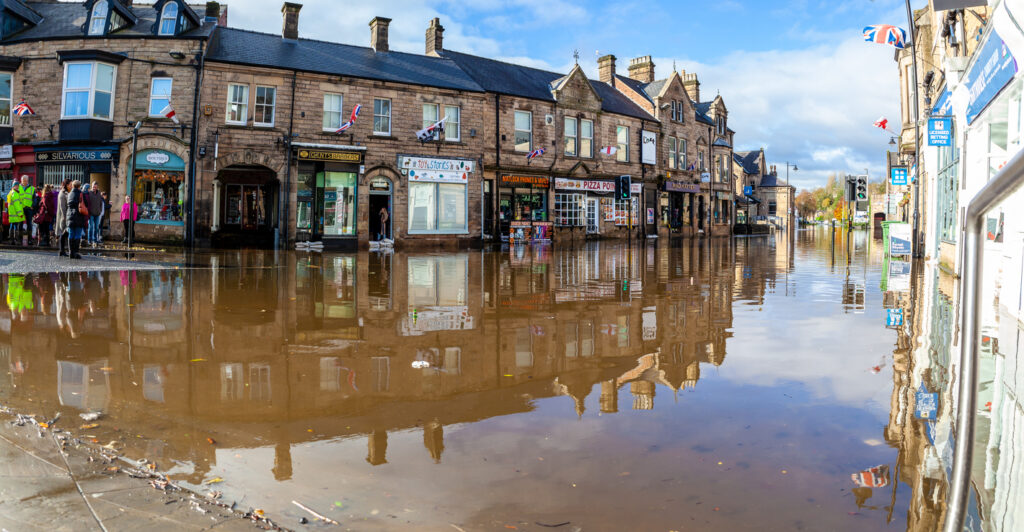How do you solve a problem like Matlock’s flood risk?
Local environmental engineers, Simon Edwards and Mark Bradbury of specialist consultancy IDOM Merebrook, explain the wider flood threat faced by one northern English town and others with similar geography and infrastructure across the UK.

Nestled in the heart of Derbyshire, the picturesque town of Matlock, popular with tourists for its stunning countryside and rich Victorian history, is plagued by a persistent risk of flooding. This year residents have endured extensive construction works within the town centre to build back flood defences.
As the project nears completion and the Environment Agency has announced a major milestone for the flood wall itself, the town is beginning to ask if this will be enough to protect local homes and business against the ever increasing threat of climate change, which is contributing to increasingly ferocious storms and rising water levels in the area.
The town has always been susceptible to flooding, with steep hills channeling run-off water from the Peak District, while the River Derwent runs directly through the town. Like many places around country, Matlock’s heightened risk of flooding is also attributed to an antiquated Victorian drainage system – once considered a remarkable feat of engineering, today it struggles with the frequency and intensity of heavy rainfall and flash events.
‘Flooding in Matlock is well documented back to early 1900s, in recent years Matlock has experienced a series of flooding events that have disrupted daily life in the town and left a trail of damage in their wake,’ says Simon Edwards, Regional Director of environmental engineering consultancy Idom Merebrook. ‘As we once again approach the wetter season in Derbyshire, the risk is particularly acute and causing concern to business owners and residents. From an engineering perspective, while significant investment has been made to reinstating protection to the town from river flooding, we question whether this alone will fix the problem.’
‘The frequency and magnitude of extreme weather events is increasingly worse as time goes on. While there is little that can be done about the sheer volume of water, measures can be put in place to better manage it by slowing the rate and controlling the flow,’ adds Mark Bradbury, Director of Engineering at IDOM Merebrook. Investing in a modern drainage system to better withstand the increased environmental challenge should be a priority.”
The drains that serve Matlock, like many built in the Victorian age, are known as combined sewers and do not separate foul and surface water. Combined sewers becoming overwhelmed by increased rainfall are causing a preventable environmental and public health problem by merging raw sewage with stormwater runoff.
These systems mean raw sewage and excess water is mixed and discharged into nearby rivers and lakes. In turn, this releases harmful pollutants leading to contamination, which can be avoided with modern drainage designs. Addressing this problem is complex, and in addition to the measures that have been put in place by the local authority, is likely to need further investment and watercourse modelling to mitigate the risk.
In addition to an overhaul of the town’s drainage system, Idom Merebrook also suggests a greater focus on Sustainable Urban Drainage Systems (SUDS). SUDS solutions, such as permeable pavements, green roofs and urban wetlands, can all help absorb rainfall and reduce the pressure on traditional sewage systems. Matlock, like many northern towns, does not have good natural infiltration and natural soakaways, with hilly terrain and clay soils contributing to flash floods.
‘It is likely that engineered solutions in the case of Matlock could offer more protection than natural defences,’ explains Bradbury. ‘A wider spread development of SUDS in the town could be helpful in slowing and spreading the flow of storm water.’While it may seem counterintuitive, Matlock could benefit from increased new housing developments if future-proofed for climate change, and appropriate measures are put in place at design stage to support better attenuation of flood water. New developments can facilitate real improvements in infrastructure and defences, and high-performance SUDS can help address and improve flood risk.’
‘In the case of large developers, compliancy may be less of an issue but it is essential that regulators insist upon all the necessary hydraulic analysis and adequate engineering designs. This may be more difficult to police with smaller developers and residents themselves altering the terrain by adding patios, driveways etcetera,’ says Edwards. ‘To their properties and we therefore must aim for a strategic view which accommodates these effects.’
‘These [steps] are all undoubtedly costly and time consuming, and need to form part of an overall assessment with detailed watercourse modelling taking into account rainfall patterns and terrain data to help design and optimise flood defence systems,’ he continues. ‘The predictive capability of watercourse modelling can be an indispensable tool in the fight against flooding by helping to determine the most effective locations for flood barriers, embankments and drainage systems. By simulating different scenarios environmental engineers can refine designs to maximise protection, while minimising environmental impact.’
More flooding and water pollution:
National Infrastructure Assessment makes net zero recommendations to UK Government
Here’s looking at you, Qatar: Water management in a desert state












